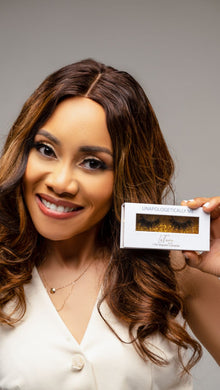Lash buyers are always curious about Jada Pinkett Smith's hair. No one could blame them - the actress is known for her luscious locks. When she suddenly started wearing hats and scarves, many people were left wondering what was going on. Some speculated that she was suffering from alopecia, while others claimed that she had simply decided to go bald. In this blog post, we will set the record straight and tell you the truth about Jada Pinkett-Smith's hair loss.
Alopecia is an autoimmune condition that causes hair loss, and it affects millions of people around the world. Jada Smith was first diagnosed with alopecia in 2015, and she has since been sharing her story in the hopes of raising awareness about the condition. In her blog posts, Jada Smith opens up about the challenges of living with alopecia, from dealing with hair loss to coping with the impact on her self-esteem. However, she also shares moments of hope and positivity, showing that it is possible to live a full and happy life despite alopecia. Alopecia takes many different forms.
DIFFERENT FORMS OF HAIR LOSS
Normally, hair grows in stages from anagen, catagen, telogen with the release of the hair from the follicle as the hair ages. Let’s look at some common reasons for hair loss: alopecia areata, hormonal, anagen effluvium, telogen effluvium, traction alopecia, and medical illness.
Alopecia Areata
Alopecia areata is an autoimmune disorder that attacks hair follicles and causes hair to fall out in patchy bald spots. . Alopecia areata can occur at any age.
Hormonal
Androgenetic alopecia is the most common cause of hair loss is male or female-pattern baldness which usually occurs gradually in over 2/3 of women and 85% of men over the age of 50, but alopecia areata has a different pattern, has various causes, and can occur at any age. Endocrine issues like polycystic ovarian syndrome or hypo/hyperthyroidism can cause increased androgen activity which can also result in the loss of brow and lash hairs.
Hair regrowth can occur naturally over time with alopecia areata, but hair doesn’t regenerate naturally with male/female pattern hair loss.
Anagen effluvium
Hair disappears quickly over a few days during the growth phase of the hair cycle after an insult. Causes include chemotherapy, radiation, toxin exposure or during certain infections. Other causes may include oral contraceptive use, iron deficiency, and malnutrition. The hair shape is irregular with a shape that is broken, tapered, narrow.
Telogen effluvium
Hair is lost after a stressful events that pushes hair into the last phase of hair growth cycle. Certain events such as weight loss, postpartum, and hemorrhage. Hair loss may occur up to 3 to 6 months after the event has ended. The hair follicle is club-shaped like it is in the hair bulb.
Traction alopecia
Wearing tight hair styles that cause pulling on hair follicle can cause temporary hair loss that may become permanent with scarring after repeated occurrence. Tweezing, waxing, and hair pulling disorders can also lead to these changes.
Medical illness
Medical conditions such as lupus, diabetes, anorexia, bulimia, fungal infections such as ringworms, anemia, and thyroid disease can cause hair loss. Medications such as antibiotics, antidepressants, blood pressure medication, corticosteroids, and others can result in hair loss.
REVERSAL OR PREVENTION
Medical treatments like corticosteroids, topical immunotherapy (minoxidil or finasteride), hair transplants, or light therapy are possible plans of action for addressing alopecia.
Nutritional Deficiency
Caloric deficiency or protein can lead to hair loss. Iron-deficiency anemia and deficiency of B vitamins like vitamin B12 and folate are also possible causes of hair loss, and replenishing hair nutrient deficiency could restore hair loss.
Heat Styling
Too much heat can cause the hair shaft to become brittle and break, causing split ends which may continue to break up the hair shaft. Sleep on satin pillowcases that will decrease the hair follicles from rubbing against them and causing breakage.
PLAN FOR DEALING WITH HAIR LOSS
Acceptance and Accessorize
One of the final stages of grief, which is what some of us actually experience with hair loss, is acceptance. Acceptance doesn’t mean that you have decided to announce to the world that you have hair loss or even that you are happy with it. You can just decide to BE no matter what.
Choices for this being include shaving your hair all off and working it like the Chic Queen you are or using wraps, wigs, hats, or whatever other items you can find to accessorize. If your alopecia affects your lashes, one option is to use products that are safe for sensitive skin. This is especially important since some forms of alopecia are caused by inflammation or sensitivities. A great option to cover missing lashes in the absence of hair is magnetic lashes and liner like the lashes from LaFarra & Co. Our magnetic liner formula is vegan and was formulated to be free from chemicals associated with most sensitivities. Did we mention that our lashes can be worn up to 60 times with proper care?
Grow it back
Once the underlying cause has been addressed, which can be done with nutrition that supports the intracellular makeup of the hair follicle and surrounding tissue. This can include options like more of certain foods high in certain fat and proteins, supplements, or even growth serums for hair or lashes and brows. Collagen and biotin are great supplements that may strengthen hair follicles. The lash and brow growth serum at LaFarra & Co. contains plant stem cells as well as peptides that help to accelerate hair growth, and it is a vegan formulation that can be used with sensitive eyes and skin. Antiinflammatory therapies such as topical corticosteroids or hemp can promote hair regrowth.
Support
Sometimes it just helps to talk about, and occasionally support groups can be found that can offer insight for how they are thriving with alopecia. It’s really important to not feel isolated and develop confidence issues when dealing with hair loss, so a therapist should also be considered as part of the treatment plan for alopecia. A decrease in stress can be a great asset when trying to regrow hair.
If you or someone you know is struggling with alopecia, please visit your doctor, dermatologist or a trichologist to find out whether your hair loss is acute or chronic so essentially you can know can be done to slow or stop further hair loss. Then love yourself no matter what plan you come up with to deal with it. It’s hair, and it’s not the only unique thing about you that makes you beautiful!










